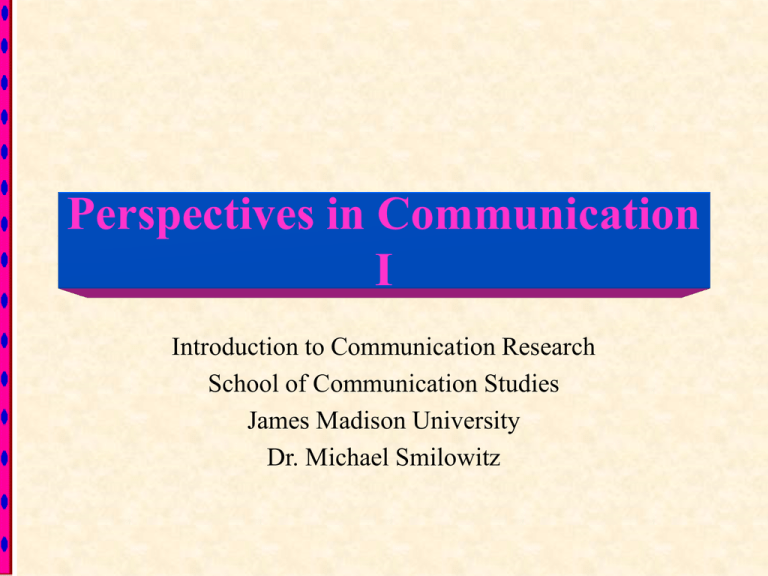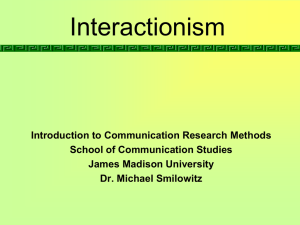Perspectives I - James Madison University
advertisement

Perspectives in Communication I Introduction to Communication Research School of Communication Studies James Madison University Dr. Michael Smilowitz Its all a matter of perspective…. Look till you see the pretty young woman. Look for the old hag. Look till you see the duck. Look till you see the rabbit. 2 Its all a matter of perspective…. What’s the point? What we choose to see is what we see! Look till you see the pretty young woman. Look for the old hag. Look till you see the duck. Look till you see the rabbit. 3 Its all a matter of perspective…. Just as you and I are influenced by our perspectives in our everyday affairs, so are the people who do research and provide theory. Fisher (1977) described the effect of perspective on theorists as relevance determining. Relevance determining means that the perspective of a researcher or theorist leads to greater emphasis given to some characteristics of the phenomenon under investigation, and less emphasis to other characteristics. 4 Its all a matter of perspective…. Metaphors are important to theoretical perspectives. – Metaphors make certain “connections.” – Metaphors provide direction to thought and inquiry. 5 Fisher’s Perspectives B. Aubry Fisher (1978) identified four perspectives to characterize research and theory building in the study of communication. These perspectives are useful for: • Organizing research. • Understanding the assumptions which guide particular researchers. • Providing a basis for evaluating research. 6 Fisher’s Perspectives The four perspectives are defined by: • Metatheoretical assumptions. • Components of communication. • Loci of communication 7 Fisher’s Perspectives The four perspectives are defined by: • Metatheoretical assumptions. • Components of communication. • Loci of communication Metatheory includes theories that explain the process of theory building. Fisher helped to identify the ontological and epistomological assumptions of each of the perspectives. 8 Fisher’s Perspectives The four perspectives are defined by: • Metatheoretical assumptions. • Components of communication. • Loci of communication Each of the perspectives emphasizes different aspects of communication and directs more attention to those components than others. 9 Fisher’s Perspectives The four perspectives are defined by: • Metatheoretical assumptions. • Components of communication. • Loci of communication Locus refers to to “place.” Each perspective differs in where it suggests that “communication” occurs. 1 0 Mechanism • The mechanistic perspective is the predominant perspective in the study of human behavior. • Conceives of humans and their behavior in machine like terms. 1 1 Mechanism: Metatheoretical assumptions • Determinism Start with this oversimplification: “A causes B” Now, get more complicated: Determinism assumes a very ordered world. In an ordered world, it is possible to predict a future event/condition based on the presence of a known antecedent event/condition or combination of events/conditions. 1 2 Mechanism: Metatheoretical assumptions • Determinism Think about a process occurring within a closed system (there are no external influences on a closed system). Shouldn’t we be able to predict the final outcome of the process if we know all the relevant information about the start of the process? For example, we should be able to predict quite accurately the destination of an arrow fired from a bow, provided we know the initial direction, the arrow’s velocity, its range, and the effect of wind. 1 3 Mechanism: Metatheoretical assumptions • Transitivity of functions (if you thought about why a process in a closed system results in a known end state, then this concept is a “piece of cake!) The sub-parts of a mechanical system transfer their functions in a linear, sequential fashion (Trenholm, 1991). Said another way, the functioning of part A leads directly to the function of B, which leads directly to the functioning of C, and so on. A B C 1 4 Mechanism: Metatheoretical assumptions • Transitivity of functions To see how simple this point really is, just think about riding your bike. As you push down on the pedal, it transfers your energy to the crank, then the chain, then the rear hub, then the rear wheel, and off you go! When transitivity of functions is assumed, it follows (think about the bike) that the functions of each component are connected and independent. 1 5 Mechanism: Metatheoretical assumptions •Material existence of components The assumption of material existence emphasizes that the important characteristics for understanding human behavior possess physical substance. –The structures of these components can be ascertained; that is to say, measured. –The relationships among components are spatial; that is, things move from one place to another (updown, here-there, near-far, and so forth). –Time is conceived in terms of constant duration -moving inexorably forward. 1 6 Mechanism: Metatheoretical assumptions •Reductionism The assumption of reductionism emphasizes that better knowledge of phenomenon comes from analyzing the phenomenon into subsequent smaller units. – A whole can be reduced to the collection of parts that comprise the whole. To promote understanding, research then examines each part, identifying even smaller units for investigation. 1 7 Mechanism: Components of Communication Research in the mechanistic perspective regards as important those aspects of communication that can be physically observed, measured, and understood for their relationships as a successive process. 1 8 Mechanism: Components of Communication The important components of communication from a mechanistic perspective include: 1. Messages as material entities. 2. Sources and receivers. In the mechanistic perspective, it 3. Noise is the channel that is regarded as 4. Fidelity the “locus of communication.” 5. Channels 1 9









